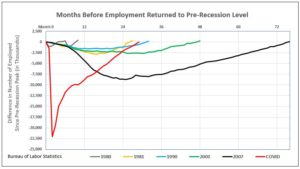Reviving the American Dream
The politics of low taxes, small government and a laissez faire attitude toward the market economy, often referred to as “neoliberalism,” is being ushered out the door by institutions supporting a “bottom-up” economy that provides well-paying jobs and support for families to grow the middle class, replacing neoliberalism’s “trickle-down” economy with its focus on tax breaks and benefits for the wealthy and big corporations.
Remarkably, impetus for this change originates from both liberal and conservative institutions. American Compass is led by Oren Cass, a former aide to Mitt Romney. It is reviewed in a recent blog post. The hypothesis advocated by American Compass is “that a labor market in which workers can support strong families and communities is the central determinant of long-term prosperity and should be the central focus of public policy.” American Compass recognizes that markets require rules and institutions to work well as “a means to the end of human flourishing and exist to serve us (not the other way around.)”
Cass has set the organization’s goal “to ensure that every person, no matter her starting circumstances, can find a vocation that allows her to support a family, live in a community where she can build a good life, and then give her children even greater opportunity than she had.” For those workers whose wages are insufficient to support a family Cass introduced a “wage subsidy” that functions similarly to the earned income tax credit. The safety net would shift from a goal of maintaining people of low income to a goal of moving them into middle class. The wage subsidy is financed through taxing wealthier workers and paying low wage earners.
The Roosevelt Institute is a liberal think tank founded in 1987 with the goal of advancing “progressive policies that bring the legacy of Franklin and Eleanor Roosevelt into the 21st century.” Its recent publication, Sea Change: How a New Economics Went Mainstream, is largely a confirmation of the economic policies of the Biden administration, including public funding of particular economic sectors and rebalancing power in the economy. Those policies have generated a doubling of investment in construction of manufacturing facilities; challenged corporate concentration; supported workers’ demands for higher wages; absorbed financial risks in developing new technologies; and directed investment to address climate change.
From the Trump administration’s Operation Warp Speed to develop mRNA vaccines, to the bipartisan legislation passed in the first two years of the Biden administration, change is evident. The Roosevelt Institute report highlighted the break from how the government responded to recession: “Rather than worrying about spending too much—as policymakers did when they crafted a response to the Great Recession— policymakers in 2021, decided that going too small was a bigger risk. They prioritized getting money into people’s pockets and workers back into jobs instead of stabilizing the financial sector.” The recession created by Covid-19, although far deeper than recessions of the past 40 years, saw employment recover in just 28 months, compared to the 76 month recovery following the recession in 2007, or the 48- and 32-month recoveries for recessions in 2001 and 1990, respectively. (Click on graph to enlarge.)
Great Recession— policymakers in 2021, decided that going too small was a bigger risk. They prioritized getting money into people’s pockets and workers back into jobs instead of stabilizing the financial sector.” The recession created by Covid-19, although far deeper than recessions of the past 40 years, saw employment recover in just 28 months, compared to the 76 month recovery following the recession in 2007, or the 48- and 32-month recoveries for recessions in 2001 and 1990, respectively. (Click on graph to enlarge.)
Between February 2020 and June 2022 employment restored the 22 million jobs lost when the pandemic began. Since June 2022 an additional 4.7 million jobs have been added, nearly returning job growth to its pre-pandemic trendline. The unemployment rate which had hit a peak of 14.7% when the pandemic started was back to 3.7% in November 2023. Average hourly employee earnings were up 6% from June 2022, while consumer prices over those 17 months increased 3.8%. The U.S. rate of inflation reached 9.1% in June 2022; the November 2023 rate was 3.1%.
employment restored the 22 million jobs lost when the pandemic began. Since June 2022 an additional 4.7 million jobs have been added, nearly returning job growth to its pre-pandemic trendline. The unemployment rate which had hit a peak of 14.7% when the pandemic started was back to 3.7% in November 2023. Average hourly employee earnings were up 6% from June 2022, while consumer prices over those 17 months increased 3.8%. The U.S. rate of inflation reached 9.1% in June 2022; the November 2023 rate was 3.1%.
These positive signs of progress have relieved most fear of a new recession. Equally encouraging is the convergence of liberal and conservative assessments as to what economic goals should be and what is necessary to achieve them – promoting job creation and supporting strong families is shared by conservative and liberal sources alike.
